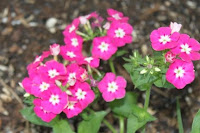

Happy Bloom Day - it's raining here and I am so relieved. Last night we got almost 2 inches and more is forecast for today and tomorrow. That will really help relieve the symptoms of emerging drought.
I love May! There are so many flowers, it's hard to know where to start. The daylilies are starting to really kick in. These are English Witch and Betty Warren Woods (yellows) and Tovarich and King Lamoni (reds), plus one little yellow one with a very traditional flower that has lost its tag. I'm still waiting on more to bloom. I'm trying to limit myself to reds and yellows. In our old house, I had 28 different varieties, but we just don't have room here.

Also blooming are newly planted Cora series vincas. This one is the spreading variety, called Polka Dot. I like vincas (or periwinkles) but I would only plant disease-resistant varieties like Cora. We've had terrible problems with fungal diseases over the years.
And I've replanted pentas here and there in my garden. Most winters, at least some of them survive, but not this one. Oh well! They grow fast. They'll be great favorites of the butterflies and hummingbirds soon.
I have some annual phlox that's been reseeding since the fall of 2008. It's crept over into the vegetable garden, but I'm leaving it there for color. It keeps this one old snapdragon company. This one also reseeded.
One of my old standbys, purple oxalis, is almost always blooming. I think it's funny -- I regard the green-leafed one as a terrible nuisance of a weed, but I like the purple one. It's just as aggressive, too. We bought one plant almost 20 years ago. Now it's everywhere.

Almost as aggressive is this gladiolus. I don't know what the variety is. It was a freebie with a bulb order maybe 5 or 6 years ago. I've dug hundreds of bulblets and given them away or thrown them away, but there's always more. I like them, but they are floppy and I don't have time to stake flowers that won't stand on their own!
I've been enjoying the butterflies this spring. They seem to particularly like the coreopsis and, of course, the milkweed. It's been a great year for coreopsis. I think it actually is blooming a little earlier than it usually does. I looked back through some old notes and apparently, at least in 2006, it was just struggling along. Now it's lush!

I still have roses blooming. Not so much as before, but Cinco de Mayo is hanging in there. I like the odd smoky orange color. The pink indigofera still has a few shabby looking flowers, but the pictures made them look even more sad than they really are, so I left them out. I do have Arrowwood Viburnum blooming, and the last flowers of these little Daisy gardenias.
The last of the really pretty amaryllis are blooming, along with the Easter lilies. They really only started blooming on Mother's Day. This year they look a little peaked to me. The amaryllis is 'Susan.'

The calendulas and calla lilies are probably also on their last legs. I like calendulas and often they reseed for me, if I don't get too impatient and replant something else there entirely.

The vegetable and herb garden are really showing off flowers! I have squash (Cocozelle), cucumbers (Straight Eight), green beans (Purple Queen), and tomatoes (Grape and Early Goliath) blooming, along with dill and society garlic!

And the prettiest flowers this May are the spring-blooming cosmos, the 'Mercer Blue' thunbergia and the mandevilla. The mandevilla is prettier still because I had to winter it over (and I hate to do that!)
Happy Bloom Day!
























































.jpg)



